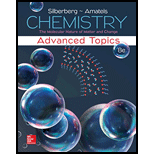
(a)
Interpretation:
The mass percentage each ion in the seawater is to be calculated.
Concept introduction:
Mass percent is defined as the mass of a component divided by the total mass of the mixture multiplied by 100.
The expression to calculate the percentage mass of ions is as follows:
(a)
Answer to Problem 2.128P
The mass percentage of
Explanation of Solution
Convert the mass of seawater from
Substitute
Substitute
Substitute
Substitute
Substitute
Substitute
Substitute
The mass percentage is the unit of concentration and is expressed as the mass of ion to the total mass of seawater.
(b)
Interpretation:
Percentage of the total mass of ions represented by sodium ions is to be calculated.
Concept introduction:
Mass percent is defined as the mass of a component divided by the total mass of the mixture multiplied by 100.
The expression to calculate the percentage mass of ions is as follows:
(b)
Answer to Problem 2.128P
Percentage of the total mass of ions represented by sodium ions is
Explanation of Solution
The total mass of ions in
The expression to calculate the percentage of
Substitute
The mass percentage of sodium ions present in the total mass is
(c)
Interpretation:
The total mass
Concept introduction:
Mass percent is defined as the mass of a component divided by the total mass of the mixture multiplied by 100.
The expression to calculate the percentage mass of ions is as follows:
The alkali metal is defined as the group of elements that are found in Group I. The alkaline earth metal is defined as the group of elements that are found in Group II.
(c)
Answer to Problem 2.128P
The total mass percent for alkali metal ions is
Explanation of Solution
The expression to calculate the ratio of the mass
Substitute
Therefore, the total mass percent for alkali metal ions is
The total mass percent for alkali metal ions is
(d)
Interpretation:
The cation or anion that has larger mass fraction of dissolved component is to be identified.
Concept introduction:
Mass percent is defined as the mass of a component divided by the total mass of the mixture multiplied by 100.
The expression to calculate the percentage mass of ions is as follows:
Ions that are formed by the loss of electrons form a positively charged ion. The positively charged ions are called cation.
Ions that are formed by the gain of electrons form a negatively charged ions. The negatively charged ions are called anion.
(d)
Answer to Problem 2.128P
The mass fraction of anion is larger than the mass fraction of cations.
Explanation of Solution
The anions that are found in the seawater are
The total mass percent of anions in seawater is calculated as follows:
Substitute
The cations that are found in the sea water such as
The total mass percent of anions in seawater is calculated as follows:
Substitute
The mass fraction of anion is larger than the mass fraction of cations.
Anions form a larger mass fraction of the dissolved components in the seawater.
Want to see more full solutions like this?
Chapter 2 Solutions
Student Solutions Manual For Silberberg Chemistry: The Molecular Nature Of Matter And Change With Advanced Topics
- Draw the mechanism to make the alcohol 2-hexanol. Draw the Mechanism to make the alcohol 1-hexanol.arrow_forwardDraw the mechanism for the formation of diol by starting with 1-pentanal in... basic conditions then acidic conditions then draw the mechanism for the formation of a carboxylic acid from your product.arrow_forwardIdentify each chiral carbon as either R or S. Identify the overall carbohydrates as L or Darrow_forward
- Ethers can be formed via acid-catalyzed acetal formation. Draw the mechanism for the molecule below and ethanol.arrow_forwardHOCH, H HO CH-OH OH H OH 11 CH₂OH F II OH H H 0 + H OHarrow_forwardDraw the mechanism for the formation of diol by starting with one pen and all in... basic conditions then acidic conditions then draw the mechanism for the formation of a carboxylic acid from your product.arrow_forward
 ChemistryChemistryISBN:9781305957404Author:Steven S. Zumdahl, Susan A. Zumdahl, Donald J. DeCostePublisher:Cengage Learning
ChemistryChemistryISBN:9781305957404Author:Steven S. Zumdahl, Susan A. Zumdahl, Donald J. DeCostePublisher:Cengage Learning ChemistryChemistryISBN:9781259911156Author:Raymond Chang Dr., Jason Overby ProfessorPublisher:McGraw-Hill Education
ChemistryChemistryISBN:9781259911156Author:Raymond Chang Dr., Jason Overby ProfessorPublisher:McGraw-Hill Education Principles of Instrumental AnalysisChemistryISBN:9781305577213Author:Douglas A. Skoog, F. James Holler, Stanley R. CrouchPublisher:Cengage Learning
Principles of Instrumental AnalysisChemistryISBN:9781305577213Author:Douglas A. Skoog, F. James Holler, Stanley R. CrouchPublisher:Cengage Learning Organic ChemistryChemistryISBN:9780078021558Author:Janice Gorzynski Smith Dr.Publisher:McGraw-Hill Education
Organic ChemistryChemistryISBN:9780078021558Author:Janice Gorzynski Smith Dr.Publisher:McGraw-Hill Education Chemistry: Principles and ReactionsChemistryISBN:9781305079373Author:William L. Masterton, Cecile N. HurleyPublisher:Cengage Learning
Chemistry: Principles and ReactionsChemistryISBN:9781305079373Author:William L. Masterton, Cecile N. HurleyPublisher:Cengage Learning Elementary Principles of Chemical Processes, Bind...ChemistryISBN:9781118431221Author:Richard M. Felder, Ronald W. Rousseau, Lisa G. BullardPublisher:WILEY
Elementary Principles of Chemical Processes, Bind...ChemistryISBN:9781118431221Author:Richard M. Felder, Ronald W. Rousseau, Lisa G. BullardPublisher:WILEY





